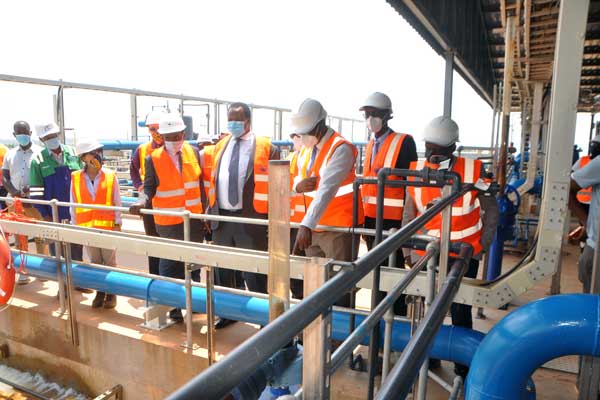Prime
NWSC now has more water than demanded in Kampala Metro

Environment Minister Sam Cheptoris (C), being shown some of the new installations at the Katosi Water Treatment Plant during a courtesy visit. PHOTO | STEPHEN OTAGE
What you need to know:
- The completion of the Katosi Water Treatment Plant has enabled National Water and Sewerage Corporation to raise it supply capacity from 240 million litres to 400 million.
National Water and Sewerage Corporation (NWSC) has said it now has about 100 million litres of surplus water within the Kampala Metropolitan Area.
The surplus, according to NWSC, has resulted from completion of the Katosi Water Treatment Plant, which had added close to 160 million litres on the water supply network within Kampala Metropolitan Area.
Speaking during a tour of the plant by Water and Environment Minister Sam Cheptoris, Dr Silver Mugisha, the NWSC managing director, said the surplus, although comes with some challenges, presents an opportunity to embark on a recruitment drive for new water connections, especially in areas where water access has been low or in areas that have previously had no access at all.
“We are working on the distribution network for places where water is not reaching. We will [put some efforts in doing] new connections,” he said, but noted that with at least 50,000 new connections per annum within Kampala Metropolitan Area, demand would have outstripped supply in the next 10 years.
Currently, he said, NSWC is producing close to 400 million litres of water per day against demand of close to 300 million litres in the Kampala Metropolitan Area.
In May last year, water consumers in the Kampala Metropolitan Area had experienced an acute shortage of water supply, which NWSC blamed on shortage of about 60 million litres within the area.
The shortage, according to NWSC, had largely led to water rationing, especially in the areas of Namugongo, Kireka, Sonde, Mukono, Kasangati and others in the eastern part of Kampala.
Kampala Metropolitan Area, which covers Kampala, Wakiso and Mukono, had by then relied on Ggaba plant, which has a daily supply of 240 million litres.
According to NWSC, the Katosi Water Treatment Plant has supply capacity of 240 million litres but would initially produce 160 million litres in addition to the 240 million litres produced by the Ggaba plant.
Mr Mugisha also noted that NWSC was in the process of developing a concept for new cities, which is expected to be funded using at least Shs300b with half of this which is 50 per cent, coming from government.
The plan, he said, seeks to generate at least seven million litres of water in the next five years for each new city, which among them include Mbarara, Masaka, Jinja, Mbale, Gulu Arua and those in the pipeline such as Hoima, Fort Portal, Soroti Moroto and Lira.
The Katosi Water Treatment Plant includes a 51-kilometre pipeline, which runs from Katosi through Mukono to Ntinda.
NWSC had also been working on reservoir tanks in Nsumba Hill, Ssonde Hill and a booster pumping station in Namugongo.
Last year, NWSC had told Daily Monitor that the project would be launched in the first part of the 2021 quarters.
However, the launch has been delayed by several months due to Covid-19 related disruptions.
Water and Environment Minister Sam Cheptoris, said the surplus water will be used to close existing supply gaps, especially in Kampala.
“Ugandans these days want value for money. I am happy the project was executed the way it was meant and I thank the corporation for completing the project in time without asking for extensions,” he said.
Engineer Badru Kigundu, the NWSC chairman, said the operationalisation and completion of Katosi Water Treatment Plant, has eliminated formerly dry zones and saturated Kampala with water.
“The supply areas of Mukono, Seeta, Sonde, Namugongo, Kyaliwajala, Kira, Bulindo, Naguru, Buwate, Kasangati, Gayaza, Namanve, Bweyogere, Kirinya, among others, which have previously been dry zones, are no more,” he said, noting that the board had approved NWSC’s 2021-2025 strategic plan as a framework for a new promise to Ugandans in line with the National Development Plan III.
Dry zones
According to Eng Badru Kigundu, the NWSC chairman, the completion of Katosi Water Treatment Plant has eliminated formerly dry zones and saturated Kampala with water.
“The supply areas of Mukono, Seeta, Sonde, Namugongo, Kyaliwajala, Kira, Bulindo, Naguru, Buwate, Kasangati, Gayaza, Namanve, Bweyogere, Kirinya, among others, which have previously been dry zones, are no more,” he said, noting that the board had approved NWSC’s 2021-2025 strategic plan as a framework for a new promise to Ugandans in line with the NDP III.




